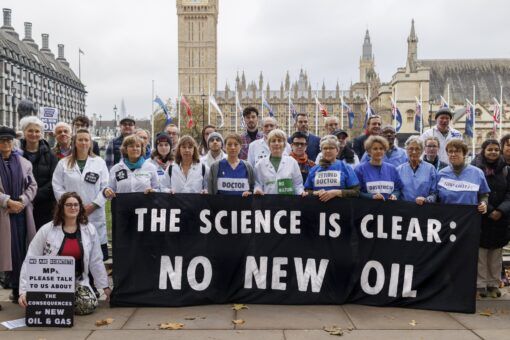
I’m on my way to do something I’ve never done before; indeed, to do something I didn’t know I could do, “green card” my member of parliament (MP). I want to speak to her about the urgency and gravity of the climate and nature crisis and the necessity of stopping all further exploration for oil and gas.
After cycling to Westminster, I chain up my bike a hundred yards from the South end of Westminster Abbey, the thousand-year-old church where William the Conqueror was crowned in 1066 and King Charles III earlier this year. I walk to meet my friend Fiona, and we try to enter the Houses of Parliament, which is also known as the Palace of Westminster. We are asked by officials why we want to enter, and we say to “green card” our MPs. They tell us that we can’t do that until 11, half an hour before the house sits. It was before 10, we have an hour to wait.
After coffee and conversation in the bowels of Central Hall Westminster, a discovery for me but an old stamping ground for Fiona, we return to Parliament and are admitted. Entering Parliament, which anybody can do, is inevitably like going through security at an airport, but the police are very friendly. You enter first into the 11th century Westminster Hall, where King Charles I was tried before being executed and Queen Elizabeth II lay in state last year. Guy Fawkes, who attempted to blow up Parliament in 1605 and William Wallace, the Scottish hero, were also tried here. Now the huge hall with its timbered ceiling is filled with scattered groups of tourists and a cavalcade of Scottish schoolchildren.
We approach a desk and ask for “green cards.“ The official tells us that we must go to the Central Lobby for that. It’s the hub of Parliament, the place you see on television journalists trying to interview MPs when something urgent is happening. At the main desk we ask for “green cards” and are given them. They are small and paper, not card. All we must do is enter our name, address, email, and the name of our MP. We do so. There’s then a space for the MP to reply.
We wait and soon encounter other climate and nature activists trying to “green card” their MPs. Most of us are doing it for the first time, but one woman, a member of Scientists for the Planet (or something similar), tells us that she has done this before and that her MP appeared within 10 minutes. She adds that the MP had never been “green carded” before.
As we wait, the crowded lobby suddenly goes quiet. Something is going to happen, but we are not sure what. The crowd forms a curve from one corridor that enters the Lobby to another corridor that leaves at a right angle. We stand at the back of the queue, waiting to see what will happen. Eventually there’s a shout of “Speaker,” and moments later a man in tights, whom I take to be Black Rod, enters followed by another man in tights carrying a mace, a man I recognise as the Speaker , and a few more officials. They enter from one corridor, wheel right, and leave by the other corridor.
“If only we paid as much attention to our democracy as to ceremony,” says Fiona wistfully.
After waiting some more, we decide that we’ll be best employed joining a photo of the mass lobbyists in Parliament Square. We are still not clear what are the commitments of an MP who is “green carded.” We have received conflicting information.
(Later, I can’t find any reference to “green carding” on the Houses of Parliament website, which seems disgraceful, although I can understand why both MPs and House of Commons officials might prefer it not to be well known. I do find information from the National Association of Head Teachers that tell us what we had been told in advance, which includes the crucial information that the MP must respond in some way.
Sure enough, the next day my MP, Florence Eshalomi, emails me, asking what I would like her to do. This is progress because I have emailed her several times and never had more than the standard out-of-office response. I suspect that she too has never been “green carded” before.)
